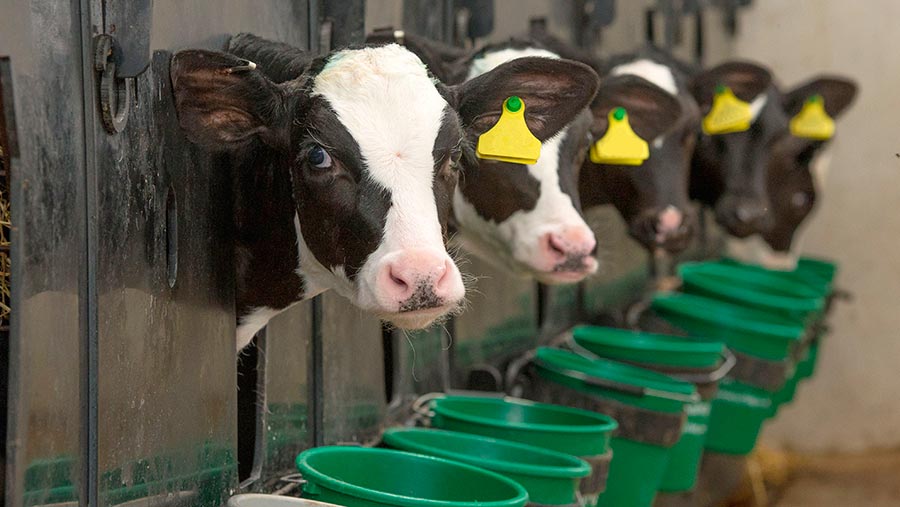How to tackle cryptosporidium in calves
 © FLAP/Rex/Shutterstock
© FLAP/Rex/Shutterstock Cryptosporidiosis is the major cause of calf scour in UK beef and dairy herds and has been identified in samples from more than 40% of diagnosed infectious diarrhoea cases.
Infected calves suffer permanent damage to the intestinal lining which reduces their ability to absorb nutrients and water.
Even when calves appear to have recovered, depressed growth rates can persist. This will push back the date at first calving and increase finishing times in beef herds so there may be an influence on lifetime productivity.
Q&A
John Yarwood of Nantwich Farm Vets, Cheshire, and Katharine Baxter-Smith veterinary adviser to MSD Animal Health, give us the low down on this costly infection.
Q. What is cryptosporidiosis and what causes it?
A.Cryptosporidiosis is an intestinal infection which can cause severe scours and high calf mortality rates. Calves become infected when they ingest the micro-organism Cryptosporidium parvum – a type of parasitic protozoan.
Part of the bug’s lifecycle is to produce huge numbers of encysted eggs – oocysts – which are shed in the faeces of infected calves, dams or other animals.
At peak shedding, there may be as many as 10 million oocysts per gram of faeces, yet, it takes as few as 10 of these to cause the disease in young, susceptible calves.
Q. What are the clinical signs?
A. Symptoms vary enormously from mild diarrhoea to severe, watery scours and eventually death.
Typically, the disease occurs in calves under six weeks old with clinical signs appearing between seven to 14-days-old. As well as scours, calves will rapidly become dehydrated and then show, ill-thrift, loss of appetite and reduced growth rates.
Q. How can you get a correct diagnosis?
A. Scour kits are available, but some can be limited in their scope so it is preferable to send samples for a lab test and discuss the appropriate action with a vet.
Q. Can you vaccinate against it?
A. No.
Q. How can you treat it?
A. The main thing to remember is scouring calves are prone to dehydration. The scouring calf must have lots of fresh, clean water available. Electrolytes can also be added to the water to replace the animal’s lost nutrients.
A further product, Halocur, is available but there are strict guidelines governing its safe use.
The major purpose of the product is as an effective prevention which it achieves by suppressing the number of viable oocysts in the calf’s system. It is licensed for use in calves with diarrhoea and will reduce symptoms, but it is not a cure.
Manufacturers, MSD Animal Health stress it is important to ensure the calf is fully hydrated and bright before use. If it is scouring, dehydrated and appears ill it can make the calf sicker and its use should be suspended.
Q. How can you prevent it?
The key areas:
The environment and pathogen reduction
Keep the environment clean by offering plenty of fresh straw to reduce moisture and fresh air.
Adhere to stringent cleaning and disinfectant programmes in between batches to reduce oocysts. Keep age groups apart because older animals can be infected and shedding the pathogen without showing clinical signs.
Workers can carry the oocysts on their boots and clothes so boot dipping and clean overalls are vital. Sick animals should be isolated for at least a week until after the scouring has stopped.
Calf health
Good colostrum management will boost the calf’s own immunity. The calf should receive good-quality, clean colostrum equivalent to 10% of its birthweight within the first six hours of life.
Halocur can also be administered to calves for the first seven days of life, particularly on farms with a history of cryptosporidiosis and where there is intense pressure on housing at calving.
Q. Which disinfectants are most effective against crypto?
Unfortunately, once introduced, the oocysts survive well in cool, moist conditions and are resistant to standard calf-house disinfection procedures.
To tackle the oocyst the disinfectant must break down its tough coating so it is important to talk to vets and manufacturers to ensure the right product is chosen (see ‘Disinfectants that tackle oocyst’, below).
Disinfectants that tackle oocyst
- 2-3% Kenocox – kills 99% oocysts after two hours of contact
- 2-4% Neopredisan – kills 99% oocysts after two hours of contact
- 10% Ox-Virin – reduced oocyst infectivity after one hour of contact
- 3% hydrogen peroxide – reduced oocyst infectivity after four minutes
- Always seek veterinary/manufacturer advice
Five-point crypto plan
- Diagnose Consult your vet. Treatments differ depending on the complex of pathogens involved.
- Clean and disinfect frequently Leave to dry to help desiccate the oocyst.
- Colostrum Supply quantity, quality, quickly.
- Control all diseases Good biosecurity, vaccination and nutritional policies will reduce the challenge to the calf’s immune system and help fend off cryptosporidium oocysts.
- Use a licensed oral product To reduce oocyst excretion and the severity of calf diarrhoea
Source: Moredun and MSD
Case study: James Oulton, Cheshire
Multipronged management plan helps cut persistent cryptosporidium

James Oulton and his son Tom have tackled crypto in their herd
A Cheshire dairy farm has used a multipronged approach to tackle a persistent cryptosporidium infection which hit growth rates and caused increased mortality.
James Oulton runs a 380-cow dairy herd at The Domvilles Farm, Barthomley, in partnership with his wife, son and parents.
Under the low input/low output forage-based system half the breeding herd is put to British Friesian genetics for replacements. The remainder produce British Blue calves for sale at four weeks to specialist rearers Buitelaar.
However, calves developed a persistent, severe scour and growth rates began to fall dramatically.
“Growth rates were suffering to the extent it was taking two weeks longer for the calves to reach weights. Mortality was also rising,” Mr Oulton explains.
The first step in tackling the problem was to have samples lab-tested for an accurate diagnosis and these revealed a complex of diseases including rotavirus and cryptosporidia.
Rotavirus was dealt with using a vaccination programme for the dams. But cryptosporidium has no available vaccine so required a preventative management plan instead.
Colostrum management was improved as a first step and all calves received an adequate supply within a maximum of six hours of birth.
Where possible calves had colostrum in the first 30 minutes after birth and stomach-tubes were used if necessary.
A rigorous cleaning and disinfection programme was also put in place that – even though housing was under pressure – ensured all pens were stripped, disinfected and rebedded before the next calf was introduced.
In addition, the farm started to use Halocur routinely, delivered as an oral dose from 24-hours-old to seven days. The product reduces the viability of the cryptosporidia in the gut and cuts the shedding of oocyst numbers, limiting the spread of the disease.
“The programme has worked and we are on top the disease now with growth rates and mortality back to where they were.”
